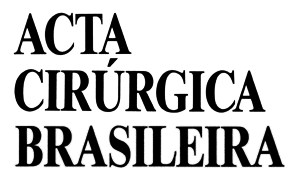Resumo em Português:
Objetivo: Avaliar, pela morfometria, se o tenoxicam com água bidestilada (diluente) ou com cloreto de sódio a 0,9% (NaCl 0,9%) provoca alterações no endotélio venoso. Métodos: Foram utilizados 90 coelhos (Oryctolagus cuniculus), brancos, da linhagem Nova Zelândia, machos, com idade acima de 10 semanas, com peso variando entre 2000 e 3500 gramas, divididos em dois grupos denominados Experimento e Controle, que foram observados nos tempos de 6h, 12h e 24h. Administrou-se nas venae auriculares dextra e sinistra, tenoxicam com seu diluente ou com NaCl 0,9% no grupo Experimento e NaCl 0,9% no grupo Controle. Para análise estatística dos resultados foi aplicada a análise de variância a um critério: a) em separado para cada grupo (Tenoxicam/NaCl 0,9%, Tenoxicam/Diluente e NaCl 0,9%), para comparar as medidas médias dos diâmetros dos núcleos das células endoteliais obtidas nos períodos de observação de 6h, 12h e 24h. Resultados: Observou-se que não ocorreram diferenças significantes entre as medidas médias dos diâmetros nucleares encontradas nos períodos de eutanásia de 6, 12 e 24h, em separado para cada grupo. As medidas médias dos diâmetros nucleares do grupo Controle foram significantemente maiores do que as observadas no grupo Experimento. Conclusão: O tenoxicam, com água bidestilada ou com cloreto de sódio a 0,9%, reduziu os diâmetros dos núcleos das células endoteliais nas venae em que foi injetado.
Resumo em Inglês:
Objective: Evaluate by morphometry, if tenoxicam with bidistilled water (diluent) or 0.9% sodium chloride, causes venous endothelium alterations. Methods: 90 white male rabbits of the New Zealand branch (Oryctolagus cuniculus) with age over 10 weeks, weight varying between 2000 and 3500 grams were used. The rabbits were divided in two groups: Experiment and Control, and analyses were conducted in 6hrs, 12hrs and 24hrs after the procedure. Into the right and left auriculares veins of the Experiment group was injected tenoxicam with its diluent or 0.9% sodium chloride; in the Control group 0.9% sodium chloride was injected. Results: Statistical differences were evaluated by One-way analysis of variance: a) apart for each group (Tenoxicam/0.9% Sodium Chloride, Tenoxicam/Diluent and 0.9% Sodium Chloride), to compare the average measures of the endothelial cells nuclei diameters obtained in the observation period of 6hrs, 12hrs and 24hrs, without significant difference among them; b) apart from the observation period (6hrs, 12hrs and 24hrs), to compare the average measures obtained, in the Tenoxicam/0.9% Sodium Chloride, Tenoxicam/Diluent and 0.9% Sodium Chloride groups, it was observed that the average measures of the nuclei diameters of the 0.9% Sodium Chloride group were significantly bigger than the ones observed in the Tenoxicam/0.9% Sodium Chloride and Tenoxicam/Diluent groups. Conclusion: Tenoxicam, either with bidistilled water or 0.9% sodium chloride, reduced the endothelial cells nuclei diameters in the veins where it was injected.
